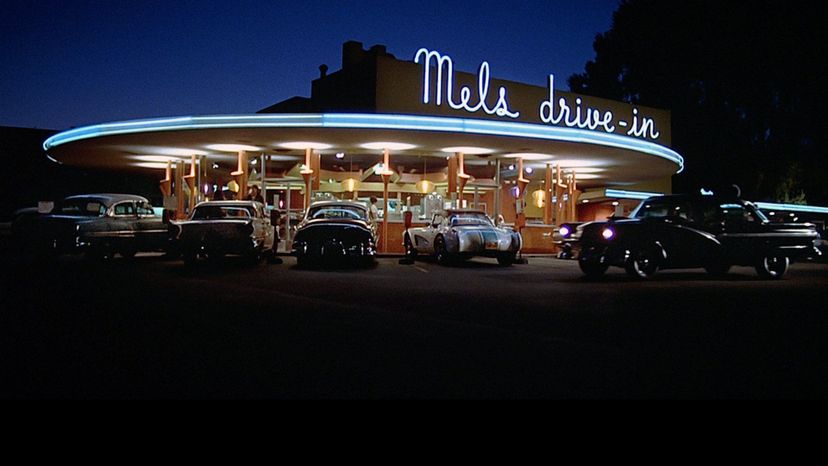
Set in 1962, the film actually premiered in 1973 with the tagline "Where were you in '62?"
The film opens at Mel's Drive-In, where Steve, Terry, Curt and Laurie are hanging out to the tune of "Rock Around the Clock."
Steve and Laurie are going steady -- until Steve breaks Laurie's heart by letting her know that he wants to be free to see other people when he heads off to college.
Advertisement
Ron Howard of "The Andy Griffith Show" plays the college-bound Steve Bolander.
Curt Henderson, a rebel who also happened to earn a scholarship from the local Moose Lodge, is scheduled to head off to college with Steve.
Steve lends his white '58 Impala to a very grateful Terry, who promises to care for the car in Steve's absence.
Advertisement
George Lucas based the Wolfman Jack character on his favorite California DJ from his own teen years.
Curt spends the evening chasing a gorgeous blond -- played by Suzanne Somers -- driving a pristine white '56 Thunderbird.
After being rejected by Judy, John gets saddled with her younger sister Carol -- played by Mackenzie Phillips.
Advertisement
Steve and Curt were graduates of the class of '62 at Dewey High School, while Laurie and Terry are part of the class of '63.
A pre-Hans Solo Harrison Ford played Bob Falfa, who wanted nothing more than to beat John's yellow deuce coup in a street race.
Class president Steve and head cheerleader Laurie dance the "snowball dance" to "Smoke Gets In Your Eyes," despite the fact that they are in the middle of a huge fight.
Advertisement
Terry dedicates himself to securing a supply of Old Harper for Debbie and himself, but is repeatedly foiled by a tough store owner and a couple of thieves.
Carlos, Ants and Joe -- aka the Pharaohs -- tangle with Curt after accusing him of scratching one of their cars.
On the long walk back to town after their car is stolen, Terry and Debbie are looking over their shoulders for the crazed Goat Killer.
Advertisement
The Pharaohs force Curt to perform an initiation in which he attaches a heavy metal cable to the axle of a police car.
A heartbroken Laurie is riding with Bob during the race when his car flips over and explodes. Fortunately, she survives and runs straight to Steve's arms.
Curt decides to head off to college as planned, while Steve stays behind to spend more time with Laurie.
Advertisement
In the movie's epilogue, viewers learn that John is killed by a drunk driver in December of '64, just two years after "American Graffiti."
After the events in the film, Curt moves to Canada, Terry is lost in action in Vietnam and Steve stays home in California.
On a shoestring budget of just $775,000, the film made $55 million in 1973 and another $63 million during a 1978 re-release.
Advertisement
The pilot for "Happy Days" was made in 1971 -- two years before "American Graffiti," though the shows are similar and both star Ron Howard.
The film went by several working titles, including "Rock Around the Block" and "Another Quiet Night in Modesto," before Lucas could convince the studios that "American Graffiti" was the right choice.
Inspired by George Lucas' adventures in his hometown of Modesto, the film was set in San Rafael, but the exterior scenes were largely set in Petaluma.
Advertisement
Despite five nominations -- including Best Picture and Best Director, "American Graffiti failed to win a single Oscar.
"More American Graffiti," which came out in 1979, followed the same cast as the first film, but covered their lives between 1964 and 1967.
The follow-up film focuses on the lives of the characters during four consecutive New Year's Eves.
Advertisement
Now that Terry is lost in battle in An Loc, Debbie Dunham has taken up a hippie lifestyle and performs with a country-western band.
Laurie wants to get a job to help support Steve and their twins, but Steve feels that a woman's place is firmly in the home.
Harrison Ford makes an uncredited cameo as motorcyle cop Bob Falfa in "More American Graffiti."
Advertisement